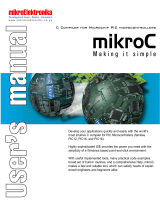
Keypad 4x4
MikroElektronika
unsigned short kp, cnt, oldstate = 0;
char txt[6];
// Keypad module connections
char keypadPort at PORTD;
// End Keypad module connections
sbit LCD_RS at RB4_bit; // LCD module connections
sbit LCD_EN at RB5_bit;
sbit LCD_D4 at RB0_bit;
sbit LCD_D5 at RB1_bit;
sbit LCD_D6 at RB2_bit;
sbit LCD_D7 at RB3_bit;
sbit LCD_RS_Direction at TRISB4_bit;
sbit LCD_EN_Direction at TRISB5_bit;
sbit LCD_D4_Direction at TRISB0_bit;
sbit LCD_D5_Direction at TRISB1_bit;
sbit LCD_D6_Direction at TRISB2_bit;
sbit LCD_D7_Direction at TRISB3_bit;
// End LCD module connections
void main() {
cnt = 0; // Reset counter
Keypad_Init(); // Initialize Keypad
ANSEL = 0; // Congure AN pins as digital I/O
ANSELH = 0;
Lcd_Init(); // Initialize LCD
Lcd_Cmd(_LCD_CLEAR); // Clear display
Lcd_Cmd(_LCD_CURSOR_OFF); // Cursor off
Lcd_Out(1, 1, “1”);
Lcd_Out(1, 1, “Key :”); // Write message text on LCD
Lcd_Out(2, 1, “Times:”);
do {
kp = 0; // Reset key code variable
// Wait for key to be pressed and released
do
kp = Keypad_Key_Click(); // Store key code in kp variable
while (!kp);
// Prepare value for output, transform key to it’s ASCII value
switch (kp) {
//case 10: kp = 42; break; // ‘*’ // Uncomment this block for keypad4x3
//case 11: kp = 48; break; // ‘0’
//case 12: kp = 35; break; // ‘#’
//default: kp += 48;
case 1: kp = 49; break; // 1 // Uncomment this block for keypad4x4
case 2: kp = 50; break; // 2
case 3: kp = 51; break; // 3
case 4: kp = 65; break; // A
case 5: kp = 52; break; // 4
case 6: kp = 53; break; // 5
case 7: kp = 54; break; // 6
case 8: kp = 66; break; // B
case 9: kp = 55; break; // 7
case 10: kp = 56; break; // 8
case 11: kp = 57; break; // 9
case 12: kp = 67; break; // C
case 13: kp = 42; break; // *
case 14: kp = 48; break; // 0
case 15: kp = 35; break; // #
case 16: kp = 68; break; // D
}
if (kp != oldstate) { // Pressed key differs from previous
cnt = 1;
oldstate = kp;
}
else { // Pressed key is same as previous
cnt++;
}
Lcd_Chr(1, 10, kp); // Print key ASCII value on LCD
if (cnt == 255) { // If counter varialble overow
cnt = 0;
Lcd_Out(2, 10, “ “);
}
WordToStr(cnt, txt); // Transform counter value to string
Lcd_Out(2, 10, txt); // Display counter value on LCD
} while (1);
}
Example 1: Program written in mikroC PRO for PIC
Figure 4: Keypad, LCD and microcontroller connection schematic
Downloaded from Arrow.com.Downloaded from Arrow.com.Downloaded from Arrow.com.









